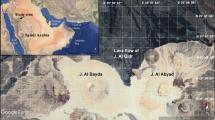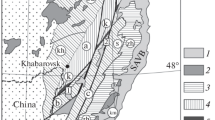Abstract
Malani Igneous Suite represents the largest felsic volcanic province in India. Despite a number of studies, the origin and the temporal extent of the Malani magmatism remain elusive. Adjacent to the Malani Igneous Suite, there exists a calcareous felsic tuff deposit at Chhoti Khatu within the younger Marwar Supergroup. It is stratigraphically separated from the Malani Igneous Suite by the Sonia Formation, the bottom-most formation of the supergroup, but falls within the temporal range of the Malani magmatism. In order to explore its genetic relationship with the Malani Igneous Suite and decipher its origin, trace element and C–O–Sr–Nd isotopic compositions of the tuff were studied. The results of the study show that the tuff differs geochemically from the MIS, and therefore, could not have been an extension of the Malani magmatism as believed by many earlier workers. On the basis of trace element patterns and Sr–Nd isotopic data, origin of the tuff is ascertained to the partial melting of Banded Gneissic Complex-II, the Archean–Paleoproterozoic basement of the region. The C and O isotopic composition of the carbonates from the tuff and a two-component mixing model reveal that the source (crustal) melt for the tuff had assimilated a significant amount of material from the rocks of the Sirohi Group. Since the timing of deposition of the tuff coincide with the emplacement of late-stage Malani dykes, it is likely that the final phase of Malani magmatism generated the heat for partial melting of the Archean–Paleoproterozoic basement.
Research Highlights
-
Chhoti Khatu Tuff differs geochemically from the Malani Igneous Suite rocks.
-
They were formed by partial melting of the Banded Gneissic Complex-II.
-
The source melt had assimilated a significant amount of material from the Sirohi Group rocks.






Similar content being viewed by others

References
Ahmad I, Mondal M E A, Bhutani R and Satyanarayanan M 2018 Geochemical evolution of the Mangalwar Complex, Aravalli Craton, NW India: Insights from elemental and Nd-isotope geochemistry of the basement gneisses; Giosci. Front. 9 931–942, https://doi.org/10.1016/j.gsf.2017.07.003.
Bhushan S K 2000 Malani Rhyolites – A review; Gondwana Res. 3 65–77, https://doi.org/10.1016/S1342-937X(05)70058-7.
Bickford M E, Basu A, Mukherjee A, Hietpas J, Schieber J, Patranabis-Deb S, Kumar Ray R, Guhey R, Bhattacharya P and Dhang P C 2011 New U–Pb SHRIMP zircon ages of the Dhamda Tuff in the Mesoproterozoic Chhattisgarh Basin, peninsular India: Stratigraphic implications and significance of a 1-Ga thermal-Magmatic Event; J. Geol. 119 535–548, https://doi.org/10.1086/661193.
Bickford M E, Basu A, Kamenov G D, Mueller P A, Patranabis-Deb S and Mukherjee A 2014 Petrogenesis of 1000 Ma felsic tuffs, Chhattisgarh and Indravati Basins, Bastar Craton, India: Geochemical and Hf isotope constraints; J. Geol. 122 43–54, https://doi.org/10.1086/674802.
Bickford M E, Mishra M, Mueller P A, Kamenov G D, Schieber J and Basu A 2017 U-Pb age and Hf Isotopic compositions of magmatic zircons from a rhyolite flow in the Porcellanite Formation in the Vindhyan Supergroup, Son Valley (India): Implications for its tectonic significance; J. Geol. 125 367–379, https://doi.org/10.1086/691186.
Carter L 2005 Granitic and rhyolitic magmatism: Constraints on continental reconstruction from geochemistry, geochronology and palaeomagnetism; MSc Thesis, University of Johannesburg, Johannesburg, 54p.
Crawford A R and Compston W 1970 The age of the Vindhyan System of peninsular India; Quart. J. Geol. Soc. 125 351–371, https://doi.org/10.1144/gsjgs.125.1.0351.
Dhar S, Frei R, Kramers J D, Nägler T F and Kochhar N 1996 Sr, Pb and Nd isotope studies and their bearing on the petrogenesis of the Jalor and Siwana complexes, Rajasthan, India; J. Geol. Soc. India 48 151–160.
Eby G N and Kochhar N 1990 Geochemistry and petrogenesis of the Malani igneous suite, north peninsular India; J. Geol. Soc. India 36 109–130.
George B G 2020 Geology of the Neoproterozoic–early Cambrian Marwar Supergroup, Rajasthan: A synthesis; Proc. Indian Natl. Sci. Acad. 86 1057–1068, https://doi.org/10.16943/ptinsa/2019/49712.
George B G and Ray J S 2017 Provenance of sediments in the Marwar Supergroup, Rajasthan, India: Implications for basin evolution and Neoproterozoic global events; J. Asian Earth Sci. 147 254–270, https://doi.org/10.1016/j.jseaes.2017.07.027.
George B G and Ray J S 2021 Depositional history of the Mesoproterozoic Chhattisgarh Basin, central India: Insights from geochemical provenance of siliciclastic sediments; Int. Geol. Rev. 63 380–395, https://doi.org/10.1080/00206814.2020.1712557.
George B G, Ray J S and Kumar S 2019 Geochemistry of carbonate formations of the Chhattisgarh Supergroup, central India: Implications for Mesoproterozoic global events; Canadian J. Earth Sci. 56 335–346, https://doi.org/10.1139/cjes-2018-0144.
Gopalan K, Macdougall J D, Roy A B and Murali A V 1990 Sm–Nd evidence for 3.3 Ga old rocks in Rajasthan, northwestern India; Precamb. Res. 48 287–297, https://doi.org/10.1016/0301-9268(90)90013-G.
Gregory L C, Meert J G, Bingen B, Pandit M K and Torsvik T H 2009 Paleomagnetism and geochronology of the Malani Igneous Suite, Northwest India: Implications for the configuration of Rodinia and the assembly of Gondwana; Precamb. Res. 170 13–26, https://doi.org/10.1016/j.precamres.2008.11.004.
Jayananda M, Santosh M and Aadhiseshan K R 2018 Formation of Archean (3600–2500 Ma) continental crust in the Dharwar Craton, southern India; Earth-Sci. Rev. 181 12–42, https://doi.org/10.1016/j.earscirev.2018.03.013.
Jochum K P, Nohl U, Herwig K, Lammel E, Stoll B and Hofmann A W 2005 GeoReM: A new geochemical database for reference materials and isotopic standards; Geostand. Geoanal. Res. 29 333–338, https://doi.org/10.1111/j.1751-908X.2005.tb00904.x.
Kaur P, Zeh A, Chaudhri N, Gerdes A and Okrusch M 2011 Archaean to Palaeoproterozoic crustal evolution of the Aravalli mountain range, NW India, and its hinterland: The U–Pb and Hf isotope record of detrital zircon; Precamb. Res. 187 155–164, https://doi.org/10.1016/j.precamres.2011.03.005.
Keto L S and Jacobsen S B 1987 Nd and Sr isotopic variations of Early Paleozoic oceans; Earth Planet. Sci. Lett. 84 27–41, https://doi.org/10.1016/0012-821X(87)90173-7.
McKenzie N R, Hughes N C, Myrow P M, Banerjee D M, Deb M and Planavsky N J 2013 New age constraints for the Proterozoic Aravalli–Delhi successions of India and their implications; Precamb. Res. 238 120–128, https://doi.org/10.1016/j.precamres.2013.10.006.
Meert J G, Pandit M K and Kamenov G D 2013 Further geochronological and paleomagnetic constraints on Malani (and pre-Malani) magmatism in NW India; Tectonophys. 608 1254–1267, https://doi.org/10.1016/j.tecto.2013.06.019.
Mishra M, Bickford M E and Basu A 2018 U–Pb age and chemical composition of an Ash Bed in the Chopan Porcellanite Formation, Vindhyan Supergroup, India; J. Geol. 126 553–560, https://doi.org/10.1086/698821.
Mukherjee A, Bickford M E, Hietpas J, Schieber J and Basu A 2012 Implications of a newly dated ca. 1000-Ma Rhyolitic Tuff in the Indravati Basin, Bastar Craton, India; J. Geol. 120 477–485, https://doi.org/10.1086/665796.
Paliwal B S 1998 Felsic volcanics interlayered with sediments of the Marwar Supergroup of Chhoti Khatu, District Nagaur, Rajasthan; J. Geol. Soc. India 52 81–86.
Pandey D K and Bahadur T 2009 A review of the stratigraphy of Marwar Supergroup of west-central Rajasthan; J. Geol. Soc. India 73 747–758, https://doi.org/10.1007/s12594-009-0060-6.
Patranabis-Deb S, Bickford M E, Hill B, Chaudhuri A K and Basu A 2007 SHRIMP ages of Zircon in the Uppermost Tuff in Chattisgarh Basin in Central India Require ~500 Ma Adjustment in Indian Proterozoic Stratigraphy; J. Geol. 115 407–415.
Purohit R, Papineau D, Kröner A, Sharma K K and Roy A B 2012 Carbon isotope geochemistry and geochronological constraints of the Neoproterozoic Sirohi Group from northwest India; Precamb. Res. 220–221 80–90, https://doi.org/10.1016/j.precamres.2012.07.012.
Rathore S S, Venkatesan T R and Srivastava R 1999 Rb–Sr isotope dating of Neoproterozoic (Malani Group) magmatism from southwest Rajasthan, India: Evidence of Younger Pan-African Thermal Event by 40Ar–39Ar Studies; Gondwana Res. 2(2) 271–281, https://doi.org/10.1016/S1342-937X(05)70151-9.
Ray J S 2006 Age of the Vindhyan Supergroup: A review of recent findings; J. Earth Syst. Sci. 115 149–160, https://doi.org/10.1007/BF02703031.
Ray J S and Ramesh R 2006 Stable carbon and oxygen isotopic compositions of Indian carbonatites; Int. Geol. Rev. 48 17–45, https://doi.org/10.2747/0020-6814.48.1.17.
Ray J S, Pande K, Bhutani R, Shukla A D, Rai V K, Kumar A, Awasthi N, Smitha R S and Panda D K 2013 Age and geochemistry of the Newania dolomite carbonatites, India: Implications for the source of primary carbonatite magma; Contrib. Mineral. Petrol. 166 1613–1632, https://doi.org/10.1007/s00410-013-0945-7.
Roy A B and Jakhar S R 2002 Geology of Rajasthan (Northwest India): Precambrian to Recent; Scientific Publishers, India.
Saltzman M R and Thomas E 2012 Carbon Isotope Stratigraphy; In: The Geologic Time Scale, 1st edn (eds) F M Gradstein, J G Ogg, M D Schmitz and G M Ogg, Elsevier, pp. 207–232, https://doi.org/10.1016/B978-0-444-59425-9.00011-1.
Sharma K K 2005 Malani magmatism: An extensional lithospheric tectonic origin; Geol. Soc. Am. Spec. Papers 388 463, https://doi.org/10.1130/0-8137-2388-4.463.
Sisodia M S 2011 Malani rhyolite: Highly eroded complex crater; Curr. Sci. 101 1–6.
Sun S-S and McDonough W F 1989 Chemical and isotopic systematics of oceanic basalts: Implications for mantle composition and processes; Geol. Soc. London Spec. Publ. 42 313–345, https://doi.org/10.1144/GSL.SP.1989.042.01.19.
Torsvik T H, Carter L M, Ashwal L D, Bhushan S K, Pandit M K and Jamtveit B 2001 Rodinia refined or obscured: Palaeomagnetism of the Malani igneous suite (NW India); Precamb. Res. 108 319–333, https://doi.org/10.1016/S0301-9268(01)00139-5.
Wang W, Cawood P A, Zhou M-F, Pandit M K, Xia X-P and Zhao J-H 2017 Low-δ18O Rhyolites from the Malani Igneous Suite: A positive test for South China and NW India linkage in Rodinia; Geophys. Res. Lett. 44 10,298–10,305, https://doi.org/10.1002/2017GL074717.
Wiedenbeck M, Goswami J N and Roy A B 1996 Stabilization of the Aravalli Craton of northwestern India at 2.5 Ga: An ion microprobe zircon study; Chem. Geol. 129 325–340, https://doi.org/10.1016/0009-2541(95)00182-4.
Xu H and Meert J G 2014 New ICP–MS U–Pb zircon ages from Khatu Rhyolites in the Jodhpur Group, India: Constraints on the Lower Age limit for the Marwar Supergroup; In: AGU Fall Meeting Abstracts, 3560p.
Yang Y H, Chu Z Y, Wu F Y, Xie L W and Yang J H 2011 Precise and accurate determination of Sm, Nd concentrations and Nd isotopic compositions in geological samples by MC-ICP-MS; J. Anal. Atom. Spectrometr. 26 1237–1244, https://doi.org/10.1039/C1JA00001B.
Acknowledgements
The author thanks J S Ray for his comments on the manuscript and for providing analytical facilities. V K Rai, S Kumar, and A Chatterjee are thanked for analytical/field support. The comments of two anonymous reviewers are gratefully acknowledged.
Author information
Authors and Affiliations
Contributions
BGG designed the study, performed the experiment, interpreted the data, and prepared the manuscript.
Corresponding author
Additional information
Communicated by N V Chalapathi Rao
Rights and permissions
About this article
Cite this article
George, B.G. On Chhoti Khatu volcanics of Rajasthan and its relationship with the Malani magmatism: A geochemical study. J Earth Syst Sci 130, 74 (2021). https://doi.org/10.1007/s12040-021-01573-7
Received:
Revised:
Accepted:
Published:
DOI: https://doi.org/10.1007/s12040-021-01573-7




